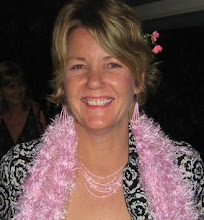
Just think, not so long ago people actually use to communicate by written mail. What an exciting thing it was to get a letter in the mail box. Now, the only mail delivered to my mail box is bills, junk mail and the occasional card.
The internet gave users a way to communicate with people from all over the world. The Blog itself was born following the 1990s. Before blogging, people communicated online using sites such as chronicles, diaries, email lists, bulletin board systems, and more.
When you create a blog it usually consists of a title, headline, body, post date, comments, tags, and more. The one great thing about blogs is that they can almost always be customized to your liking. Your template, which determines how your blog looks, including its layout, is usually provided by the blogging company you are using.
There are so many possibilities with blogging. Using your imagination and creativity, there is no end!
I would love to use a blog in my classroom to post reflection questions home to my students and ask them to respond to their current work, participation etc. While critical reflection is viewed by some educators as a learning strategy that can be taught in the classroom, others question the usefulness of it, citing the lack of a consistent way to measure the depth and outcome of critical reflection (Stein, n.d.). For myself, critical reflection enables me to evaluate, not only my work, but my participation and current practices, therefore using a blog in this way in the classroom could be a valuable tool for self assessment and self improvement.
The internet gave users a way to communicate with people from all over the world. The Blog itself was born following the 1990s. Before blogging, people communicated online using sites such as chronicles, diaries, email lists, bulletin board systems, and more.
When you create a blog it usually consists of a title, headline, body, post date, comments, tags, and more. The one great thing about blogs is that they can almost always be customized to your liking. Your template, which determines how your blog looks, including its layout, is usually provided by the blogging company you are using.
There are so many possibilities with blogging. Using your imagination and creativity, there is no end!
I would love to use a blog in my classroom to post reflection questions home to my students and ask them to respond to their current work, participation etc. While critical reflection is viewed by some educators as a learning strategy that can be taught in the classroom, others question the usefulness of it, citing the lack of a consistent way to measure the depth and outcome of critical reflection (Stein, n.d.). For myself, critical reflection enables me to evaluate, not only my work, but my participation and current practices, therefore using a blog in this way in the classroom could be a valuable tool for self assessment and self improvement.

Once you have set up a blog, it's a good idea to attach a RSS Aggregator. A RSS Aggregator is a device that attaches the user to other blogs and provides updates of blogging action. When set up, information flows to you instead of you spending hours searching for it. Hence the name Really Simple Syndication!
Below is a the YouTube clip "RSS in Plain English" take a look for more information of how it works.
Stein, D (n.d.). Teaching critical reflection. Retrieved 13th August, 2009, from http://www.inspiredliving.com/business/reflection.htm
What's a blog. Retrieved August 7th, 2009, from http://www.blogger.com/tour_start.g
Image.Retrieved August 7th, 2009, from http://www.freedigitalphotos.net/

Hello Rhonda,
ReplyDeleteBlogs are l whole new world really. There are so many fantastic ways that we can introduce them into our classrooms.
I am beginning to think that most people in this course are of the same opinion, as there appears to be quite a few blogs appearing in our oral presentations. I think you could say "we have taken this tool and run with it!".
Chat again soon and keep up the great blogging.
: ) Kerri.